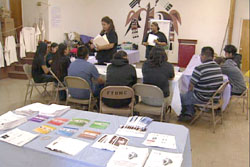
|
||||||||
| Native American Teens Learn Facts about HIV, AIDS | |||||||
|
Most weekends you'll find 14-year-old Janyse Collins hanging out with her friends or chatting online about almost anything. But this weekend, Janyse and her friends are tackling a subject matter that doesn't normally pop up on their computer screen: AIDS. "I haven't heard of too many people I know who have AIDS," Janyse says, "but I think it's a serious problem for our people." Janyse's people are Native Americans, and HIV/AIDS is becoming a serious problem in her community. According to the Centers for Disease Control, Native Americans have the third-highest infection rate of any U.S. population. Native Americans face some unique challenges when it comes to fighting the disease, including a high poverty rate, a young population, limited access to HIV testing and treatment, and the misconception that AIDS is a "white man's" disease. "I always think it's somebody else," Janyse admits. "I never thought our native people would do stuff to get the disease." But the CDC numbers highlight a stark reality: Native Americans have seen higher infection rates than whites since 1995. So on a Saturday in mid-March, Janyse and 14 of her friends are sitting in the Fort Yuma United Methodist Church on the Quechan Reservation in southern Arizona getting the facts about sex, disease and HIV. They are all participating in a four-day Teen Empowerment program designed for Native Americans. Making better choices Christina Allen, who works for the Quechan alcohol and drug abuse prevention program leads the seminar on this day. "Do any of you know about HIV and AIDS?" she asks. The kids shake their heads in silence. "Good, because we're going to learn about that today." Throughout the rest of the day the kids role-play, take quizzes and talk about everything from sexually transmitted diseases to peer pressure. There's some nervous laughter, along with a few red faces, but the teens listen intently. "I want to protect these kids," says Allyson Collins, Janyse's mom. "I know they'll make their own decisions, but I want to at least give them the opportunity to give them information so they can make better choices for themselves." Collins is a member of the Fort Yuma United Methodist congregation. She organized the seminar with Janyse and her 13-year-old sister, Jessica, in mind. "Probably what motivated me were my daughters and the age that they are at." Breaking silence Respecting and listening to elders is an important part of the Native American culture, but Collins knows this is one reason AIDS is still a taboo subject. "Just in our own culture," she says, "we don't discuss those things with our elders." At the seminar, the teens discuss everything. The Teen Empowerment program teaches abstinence, but no subject is off limits. During one role-playing game, the teens are assigned letters and then asked to shake hands with three others. The hand shaking represents sexual activity. The teens soon discover that some of the teens they've shaken hands with represent people with genital herpes, and a few others represent people infected with HIV. Though some used condoms, the only two people who come out disease-free are the two girls who were told not to shake any one's hand. They practiced abstinence. The rest of the group applauds the girls. "Each one of these kids is a leader in their own way," Collins says. "I know that what they learn from this class they can take it back to their circle of friends." In another room at the church, a group of Native American parents is making a list of teen terms. "Rad," says one mom. "Cool," says another. They're getting a lesson in how to talk with their kids about sex and disease so that the conversation doesn't end when the seminar wraps up. Before the seminar, Janyse had said she wanted to come to "get knowledge of what's going on in the Indian country and see what's taking over our Indian kids." She had noted with seriousness that "if they keep dying of HIV then we're not going to have any more native people." Still, Janyse isn't worried about the long-term impact of AIDS. "Kids are getting smarter now." Through programs like Teen Empowerment, they are. |
|
||||||
 |
Last
Updated
April 22, 2006




